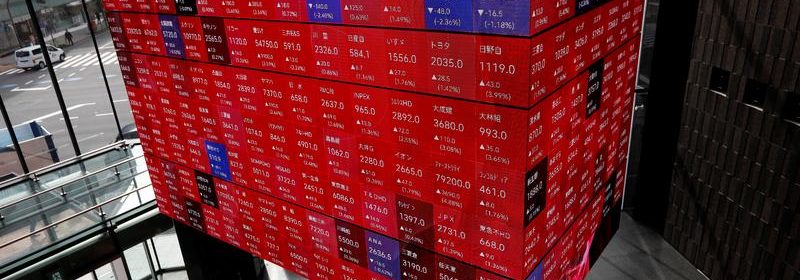Stocks stalled as oil fuels inflation nerves

SYDNEY (Reuters) – Asian stockmarkets were tugged lower by fresh concern about the solvency of China’s property developers on Wednesday, while a surging oil price added to worries that a hot U.S. inflation reading could renew pressure on policymakers to lift rates.
Brent and U.S. crude futures extended gains into a fourth session, hitting two-week highs around $85 a barrel. Another warning came from Chinese factory gate prices, which are gaining at their fastest clip in a quarter century.
S&P 500 futures fell 0.4%. FTSE futures and European futures each lost 0.2%. At 1330 GMT, U.S. inflation figures are expected to show consumer prices galloping ahead at 5.8% year-on-year, the fastest pace in a generation.
Even dovish Federal Reserve officials have conceded it is running hotter for longer than they thought.
“These inflation numbers are unlikely to make anyone feel comfortable,” said ING economist Rob Carnell. “Inflation higher for longer than expected is becoming the market’s considered opinion right now, and its likely we get reinforcement of that.”
Ahead of the data U.S. equities snapped a long winning streak with modest falls on Tuesday and on Wednesday MSCI’s broadest index of Asia-Pacific shares outside Japan dropped 0.6%. Japan’s Nikkei fell 0.5%.
Longer-dated Treasuries have rallied in recent sessions, flattening the yield curve as investors wager on hikes in the next year or so squashing growth in the years beyond. [US/]
Treasuries dipped a bit in Asia hours, lifting the benchmark 10-year yield about 2 basis points to 1.4626% after it had touched a six-week low of 1.4150% on Tuesday.
Currency markets have been fairly quiet but traders favoured safe havens on Tuesday and lifted the yen to a one-month high.
The Japanese currency held there on Wednesday at 112.84 per dollar and risk-sensitive currencies such as the Australian dollar were under pressure, with the Aussie falling through its 50-day moving average to $0.7366. [FRX/]
“The dollar will be sensitive to moves in the 2-5 year part of the U.S. Treasury curve,” said Chris Weston, head of research at broker Pepperstone in Melbourne.
“I think we’ll need to see a (monthly U.S. CPI) print of 0.8% to see the dollar index break out of the top of the range of 94.50,” he said. The index was last steady at 94.045.
CLOUDS
China’s economic slowdown is also nagging on investors’ minds, especially as a credit crunch seems to be quickly spreading through the giant property industry.
Bonds in the sector have suffered a fresh drubbing and on Wednesday shares in developer Fantasia Holdings halved upon return from a six-week trading halt as the company warned it might not be able to meet its debt obligations.
A gloomy demand outlook has pushed iron ore to a 19-month low selling in banks and property stocks in Hong Kong pulled the Hang Seng down 1% to a one-month low. [.HK][IRONORE/]
“(The) market is now driven more by fear rather than rationale,” said analysts at J.P. Morgan. “Valuations have factored in (the) worst case scenario.”
Other clouds are also gathering, with a survey in Japan showing manufacturers’ business confidence has fallen to a fresh seven-month low and Tesla stock, a bit of a gauge of retail investors’ sentiment, turning wobbly.
The carmaker, which has been the poster-stock of equities’ thumping rally from pandemic lows, suffered its sharpest share price fall in 14 months on Tuesday as traders brace for a possible sale from company chief Elon Musk.
Gold and bitcoin have been the primary beneficiaries of the market turbulence, with gold up about 3.5% in a week to $1,826 an ounce and bitcoin hovering at $66,400 after hitting a record of $68,564 a day ago.
Source: Read Full Article
